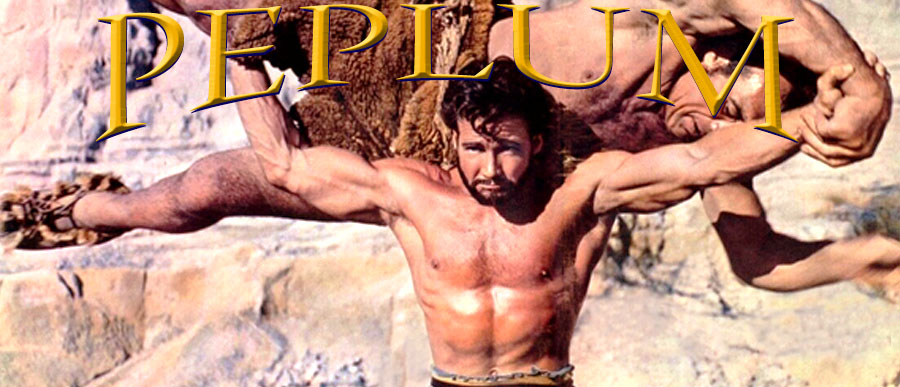HERCULES was the bigger hit and its influence was that Beefcake, or muscular actors, were now a selling point. Except for Tarzan films, in Hollywood, Beefcake was always secondary to Cheesecake, which reigned supreme (and still does today). After its success came a myriad of auctioners or dramas set in Antiquity or across the seven seas, which often had a shirtless hero defeating evil rulers by the sheer will of his good intents, and with the help of his much developed sinewy body. Not all PEPLUM films were like HERCULES but many, including Swashbucklers, had to have a beefy hero, who often wore little clothes, and was the central figure of the film though most of the supporting roles often propelled the story. The heroes in PEPLUM movies always had an air of mystery to them which forced screen writers to shape the story in a way that wasn’t too revealing of the hero’s mystique. Though they were made for adult audiences, these films were really popular with kids, certainly boys and young men.
Clockwise : Richard Harrison, Mark Forest, Kirk Morris, Alan Steel, Gordon Scott, Peter Lupus, Dan Vadis and Iloosh Koshabe
European studios cranked out these films by the dozens a year. Quality varied but technically most of them were pretty constant : Technicolor or some variation of the film process. And Cinemascope or some less expensive variation of the film format. Today, when they are released on DVD in pristine conditions, these "low quality" productions look absolutely amazing. There was quality behind them. Just not super high quality like many (turgid) Hollywood epics.
With the smashing success of HERCULES, the Beefcake hero was finally born and this influence would stay with us up until today. Coming in different waves, having bodybuilders play heroes in PEPLUM films, or action films became the norm. Arnold Schwarzenegger and host of bodybuilders or models were the staple of action films throughout the 1980s. Even today, with a new generation of muscly actors like Dwayne Johnson and Kellan Lutz continue the tradition that started with the casting of Steve Reeves as Hercules. Critiques often ridicule this aspect of these films. These bodybuilders or models were (or are) not actors, but most of critics rarely understand the point of having a muscly hero : it was to show the human body in motion. Heroes would do things, like feats of strength or simply by battling the enemy, to demonstrate the suppleness and artistry of the male physique.
This influence would spill over into mainstream Hollywood films. More and more films featured “beefcake” players. The films of Joshua Logan certainly was one of the few directors in Hollywood who used muscular actors in his films. Navy comedies like OPERATION PETTICOAT and ENSIGN PULVER capitalized on this trend. Many of the actors who appeared in these Hollywood films as supporting actors eventually went on to Europe to appear in leading roles thanks to the new PEPLUM explosion. Gordon Mitchell, who appeared in THE TEN COMMANDMENTS, or Ed Fury and Ken Clark (left) in SOUTH PACIFIC, became the main stars, not bit players.
But as much influence as HERCULES had, and it was a game changer in many aspects, the trend of having beefy heroes would always be something that strictly came from Europe and not Hollywood, which simply couldn't compete with the casual display of the male physique. This would change in the 1980s after the success of CONAN, and later on again in the 2000s, with the success of 300. But during that period, Hollywood was still uneasy with too much skin, male or female, and European productions always retained an edge over US films. One just has to look at the costumes between Hollywood films and European/ Italian productions :
Richard Egan in THE 300 SPARTANS versus Gordon Scott in CORIOLANUS : HERO WITHOUT A COUNTRY
Costumes in PEPLUM films made in Hollywood were always more conservative than those from Europe, which were more accurate, with a few exceptions here and there. This casual disregard to male flesh would even make today’s audiences uncomfortable. Remember, most of these films were marketed to kids. No kids film today would show something like this :
Ed Fury mounting a horse in THE MIGHTY URSUS. You'll never see something like this in films made in Hollywood.
 Oddly enough, though HERCULES spawned this trend and director Pietro Francisci wasn’t shy in showing Reeves’ physique, those films were careful in not showing actual nudity, like naked buttocks or bulges. I'll go over this next week.
Oddly enough, though HERCULES spawned this trend and director Pietro Francisci wasn’t shy in showing Reeves’ physique, those films were careful in not showing actual nudity, like naked buttocks or bulges. I'll go over this next week.But not everyone was happy about this. Today, these films are often seen as worthless because of the amount of the muscles and casual quasi male nudity. In comparison, films like ONE MILLION YEARS BC are fondly remembered for displaying curvaceous beauties like Raquel Welch (right, with John Richardson) but PEPLUM films have been (and still are) derided for its prominence of Beefcake (I’ll write more on the “cavemen” trend of the 1960s in a future post).
This nonchalance view of the male physique is so legendary that the 1980 comedy AIRPLANE had a now infamous line : Joey, do you like movies about gladiators?
More on this next week!
Previous posts of the on-going subject can be read at the permanent page : link








2 comments:
I enjoyed reading your post. Thank you for offering it.
I'd like to say that what the European Peplums have and the Hollywood epics lack is effervescence. The Roman and Biblical films churned out in the US during the 1950's and 60's are mostly pretty turgid affairs. It's as if we, the audience, must bow our heads to the subject matter and consume it in quiet contemplation. It's almost impossible to get emationally invested in the films.
Post a Comment